What You Should Know About Fertilizing Trees And Shrubs
Healthy and gorgeous trees need year-round care. Aside from maintenance musts like regular pruning and proper watering, knowing when and how to fertilize your trees and shrubs helps promote healthy growth and longevity. However, if you’re not quite sure how to adequately maintain your leafy companions, have no fear. Below, we have compiled a list of easy-to-follow steps for fertilizing and caring for your trees and shrubs.
What Is a Tree Fertilizer?
Tree fertilizer is a formulated substance rich in essential nutrients designed to enhance growth or remedy a diagnosed nutrient deficiency. Using properly applied fertilizer can help to improve the health and appearance of your trees by replenishing soil nutrients that may be lacking, thereby promoting overall tree vitality.
What Does a Tree Fertilizer Do?
A tree fertilizer provides trees and shrubs with crucial macronutrients such as nitrogen, phosphorus, and potassium, which can support lush foliage, and improved resistance to stressors. This in turn can foster stronger growth and better resilience.
While fertilizer can make a big difference to the health of trees and shrubs, the only circumstance in which it is needed to promote plant health is to remedy a known deficiency. If a tree or shrub is planted in the right place fertilizer should rarely be necessary. The exception to this rule would be to promote more rapid growth of younger plants to meet the aesthetic needs of the owner.
What to Expect from a Tree & Shrub Fertilizer?
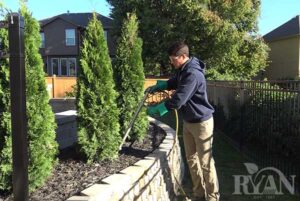
Landscape plants and shrubs often need fertilizer to grow and bloom to their fullest.
When using a tree fertilizer to improve plant health due to a known nutrient deficiency, you can expect more vigorous growth and a return to normal colored foliage. To achieve the desired results, tree fertilizer must be applied to the roots so the tree can absorb the supplied nutrients.
Who Should Consider Tree Fertilization?
Anyone can benefit from tree fertilization. It is recommended for homeowners, landscapers, and arborists aiming to enhance the aesthetics of trees. It can be particularly advantageous for trees showing signs of nutrient deficiency, slow growth, or stress due to factors like urban environments, compacted soil, or construction activities.
Tree fertilization is also common for homeowners in new subdivisions who want to speed up the growth of their trees and shrubs.
When to Fertilize Trees
Ryan Lawn & Tree uses fertilizers designed to slowly release nutrients over time in a controlled manner. The best time to fertilize trees is during their active growing seasons, typically in the spring and early fall. This schedule provides essential nutrients for optimal growth and development at crucial times.
Fertilize the Young Ones
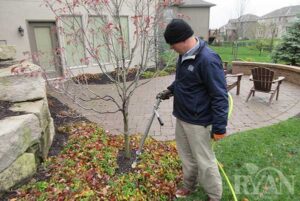
Use Fertilizers Formulated for Trees
When it comes to fertilizing trees and shrubs, always avoid anything specifically formulated for lawns. While trees and shrubs require the same types of nutrients as grass, they need different amounts of each in a fertilizer tailored to meet the plants’ needs to have a positive effect. This has a lot to do with the different ways in which the plants grow, but also the depth of their root systems. Utilizing products labeled for tree and shrub use should offer the nutrient balance and rates necessary for these differences.
When Not to Fertilize Trees
Avoid fertilizing trees during their dormant periods as well as during periods of extreme heat or drought, as this can stress the trees and potentially lead to nutrient imbalances or root damage.
Fertilizer Is Not a Cure-All
Fertilizer is not a cure-all and cannot replace proper care and maintenance, or be expected to remedy any issue that arises. Most of the stressors that affect tree and shrub health are insects, disease, environmental factors, or even problems related to the age of the plant.
Fertilizer’s only real purpose is to remedy a known nutrient deficiency or to achieve the objective of promoting growth in any given plant material. The best way to keep your trees and shrubs healthy is to follow an ongoing maintenance plan that involves watering, pruning, and inspections to help you spot signs of disease, insect infestations, and other problems early on so that you have a better chance of rectifying the issue and restoring the tree to good health.
Should a Tree Fertilizer Be Used for Short-Term and Long-Term Applications?
Yes, tree fertilizers can be used for both short-term and long-term applications, depending on the specific goals and needs of the trees. It’s a good idea to consult with an experienced arborist who can inspect your trees to diagnose any current issues that you need to address, as well as to recommend an application schedule that takes into consideration the unique needs of your trees based on their species, the soil conditions, surrounding environment, and the climate.
Short-term Application
In situations where trees show signs of immediate nutrient deficiency or stress, a short-term application of fertilizer can provide a quick boost of essential nutrients. This can help quickly alleviate symptoms like yellowing leaves or slow growth and provide a temporary solution to address the tree’s immediate needs. However, long-term measures are needed to support the trees’ ongoing health and vitality.
Long-term Application
For the sustained health and growth of trees, long-term or regular fertilization is sometimes recommended. Long-term application involves providing a steady supply of nutrients over an extended period. This approach supports consistent growth. Regular fertilization is especially important in urban environments where trees might face nutrient-depleted soils due to factors like pollution or limited access to natural nutrient sources.
It’s important to note that the choice of fertilizer, application timing, and frequency should be tailored to the specific tree species, soil conditions, and local climate. Consulting with a professional arborist or horticulturist can help determine the most appropriate fertilization strategy for your trees’ short-term and long-term needs.
Tree Fertilization Pros and Cons
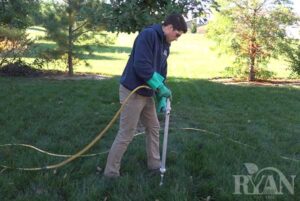
To maintain their health and vigor, tree fertilization has become a common practice. However, like any intervention, it comes with both advantages and potential drawbacks. Explore the pros and cons of tree fertilization to understand the key aspects that help arborists, gardeners, and tree enthusiasts make informed decisions about tree care.
Pros of Tree Fertilization
Improved Growth and Health
Fertilizers provide essential nutrients that trees require for growth. The three main ones are nitrogen, phosphorus, and potassium. These macronutrients are vital for leaf development, root growth, and overall tree vitality.
Faster Recovery
Trees that have suffered damage from storms, pests, or diseases are vulnerable and can benefit from fertilization. In the case of nutrient deficient trees, the right treatments can accelerate their recovery by providing the necessary nutrients required for both healing and new growth.
Soil Improvement
Fertilizers can help to enhance soil fertility by replenishing nutrients that may be depleted over time due to land use practices.
Cons of Tree Fertilization
Nutrient Imbalance
Over-fertilization or improper ratios of nutrients can lead to nutrient imbalances, which may harm the tree more than it helps. Excessive nitrogen, for instance, can result in rapid but weak growth, making the tree more susceptible to disease and damage.
Environmental Impact
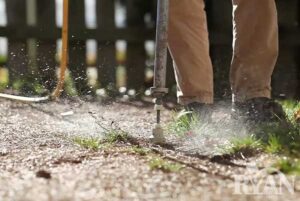
RYAN Pros know how to properly apply deep root fertilizer safely and effectively.
Runoff from fertilized trees can contribute to water pollution, as excess nutrients may leach into nearby water bodies, causing issues such as algal blooms and reduced water quality. It’s important to work with experts trained in tree health who can analyze the situation to proceed with targeted treatments that address the trees’ needs while limiting the impact on the surrounding environment.
Root Damage
Misapplication of fertilizers can lead to root burn or damage. Fertilizers that are not properly distributed can harm the sensitive root system of trees.
Cost and Effort
Fertilization requires resources like time, labor, and money. For large landscapes or multiple trees, the cost of fertilization, especially when performed by professionals, can be significant.
Unintended Consequences
Fertilization may inadvertently promote the growth of invasive plant species or disrupt the balance of the local ecosystem, impacting native plant and animal populations.
The Importance of Proper Tree Fertilization Applications
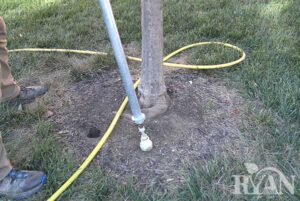
However, tree fertilization requires a cautious approach, ideally by a professional who understands the specific needs of each tree species and the surrounding ecosystem. Proper application techniques, careful selection of fertilizers, and consideration of environmental impacts are crucial to mitigate potential drawbacks. When implemented thoughtfully, tree fertilization can contribute to a greener, more vibrant world where trees continue to thrive and provide essential benefits to both nature and society.
Real Benefits of Choosing RYAN Tree Fertilization
RYAN has been in business since 1987 and has built a strong reputation for delivering top-notch tree fertilization services and exceptional customer support. Our team of dedicated professionals is employee-owned and rigorously trained to ensure the highest quality service in all of our service areas:
At RYAN, our mission is to assist our clients in cultivating beautiful and thriving landscapes. We are a leading tree fertilization company with a proven track record of delivering successful tree treatments, leaving homeowners delighted with the results.
Need Help Caring for Your Trees and Shrubs?
The experienced professionals at RYAN Tree Care Services can help you install and maintain beautiful, healthy trees and shrubs all year long. Our Pros can inspect your property to create a personalized care plan with customized resources to keep your existing trees looking their best while providing recommendations for new trees that will thrive as part of your landscaping aesthetic. Contact us today for a your Tree Care Free Estimate!









